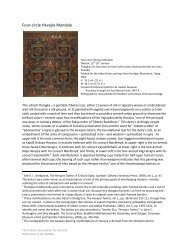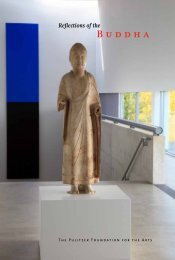Womb World Mandala (TaizÅkai mandara) - Reflections of the Buddha
Womb World Mandala (TaizÅkai mandara) - Reflections of the Buddha
Womb World Mandala (TaizÅkai mandara) - Reflections of the Buddha
Create successful ePaper yourself
Turn your PDF publications into a flip-book with our unique Google optimized e-Paper software.
<strong>Womb</strong> <strong>World</strong> <strong>Mandala</strong> (Taizōkai <strong>Mandala</strong>) 10<br />
M. Brauen, The <strong>Mandala</strong>, Sacred Circle in Tibetan Buddhism. London: Serindia Press (1997).<br />
Richard Bowring, “Preparing for <strong>the</strong> Pure Land in Late Tenth-Century Japan”, in Japanese Journal <strong>of</strong><br />
Religious Studies, Vol. 25, No. 3/4 (Fall, 1998), pp. 221-257.<br />
David Gardiner, “<strong>Mandala</strong>, <strong>Mandala</strong> on <strong>the</strong> Wall: Variations <strong>of</strong> Usage in <strong>the</strong> Shingon School”, in Journal<br />
<strong>of</strong> <strong>the</strong> International Association <strong>of</strong> Buddhist Studies 19, 2 (1996), pp. 245 - 279.<br />
Elizabeth ten Grotenhuis, Japanese <strong>Mandala</strong>s: Representations <strong>of</strong> Sacred Geography. Honolulu:<br />
University <strong>of</strong> Hawaii Press (1999).<br />
Elizabeth ten Grotenhuis, “Rebirth <strong>of</strong> an Icon: The Taima <strong>Mandala</strong> in Medieval Japan”, in Archives <strong>of</strong><br />
Asian Art, Vol. 36 (1983), pp. 59-87.<br />
Yoshito Hakeda, Kukai: Major Works Translated, with an Account <strong>of</strong> His Life and a Study <strong>of</strong> his Thought.<br />
New York: Columbia University Press (1972).<br />
Joseph M. Kitagawa, "Master and Savior," in Nakano Gishō (ed.) Studies <strong>of</strong> Esoteric Buddhism and<br />
Tantrism. Kyoto: Naigai Press (1965), pp. 1-26.<br />
Joseph M. Kitagawa, Religion in Japanese History. New York: Columbia University Press (1966).<br />
Minoru Kiyota, “Shingon Mikkyō <strong>Mandala</strong>”, in History <strong>of</strong> Religions, Vol. 8, No. 1 (Aug., 1968), pp. 31-59.<br />
Peter Knecht, “Ise sankei <strong>mandara</strong> and <strong>the</strong> Image <strong>of</strong> <strong>the</strong> Pure Land”, in Japanese Journal <strong>of</strong> Religious<br />
Studies, Vol. 33, No. 2, Varieties <strong>of</strong> Pure Land Experience (2006), pp. 223-248.<br />
Yukio Lippit and Anne Rose Kitagawa, Marks <strong>of</strong> Enlightenment, Traces <strong>of</strong> Devotion: Japanese Calligraphy<br />
and Painting from <strong>the</strong> Sylvan Barnet and William Burto Collection. Harvard University Art Museum<br />
Gallery Series, No. 44, Cambridge, MA (2004).<br />
Shunshō Manabe, “Meaning <strong>of</strong> <strong>the</strong> Esoteric <strong>Mandala</strong>s in Japan”, in Moritake Matsumoto, ed.,<br />
Proceedings <strong>of</strong> <strong>the</strong> Itobei Ohira Memorial Conference on Japanese Studies. Vancouver: Institute <strong>of</strong> Asian<br />
Research, University <strong>of</strong> British Columbia (1984).<br />
Miyeko Murase and Masako Watanabe, The Written Image: Japanese Calligraphy and Painting from <strong>the</strong><br />
Sylvan Barnet and William Burto Collection. New York (2002) pp. 76 - 83.<br />
The Pulitzer Foundation for <strong>the</strong> Arts<br />
<strong>Reflections</strong> <strong>of</strong> <strong>the</strong> <strong>Buddha</strong>




